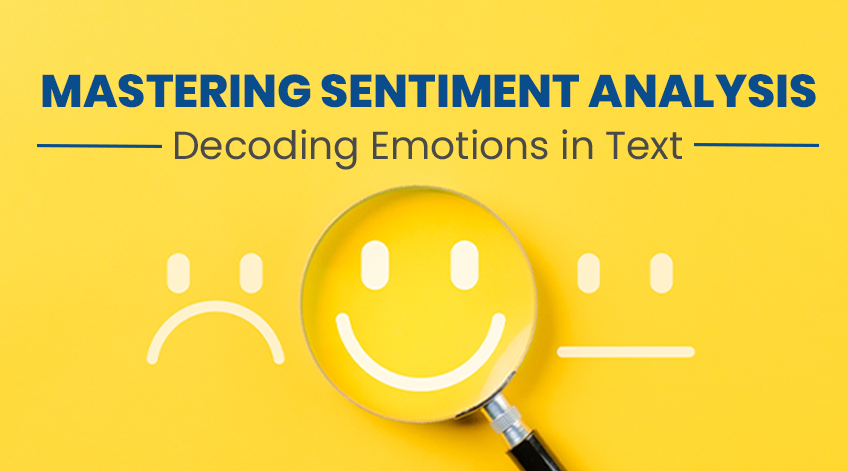Introduction
Sentiment analysis is crucial in all businesses, and business leaders desire to understand the customers' feelings, opinions, and comfort with their products and services. This exercise is a fundamental phenomenon, and they keep enhancing the parameters mentioned. They always keep an eye on that and assign a dedicated team to follow up, bring the data, and improve their way of competing with their market challenges and other leading competitors.
In the Big-Data world, 3V capabilities such as volume, variety, and velocity make this exercise feasible to play a global role precisely, enhance the opportunities and sustainability in the market as long-time leaders, and retain them among global customers.
This article will discuss how sentiment analyses are carried out by decoding the emotions in text and replicating them into business approaches to enhance actionable strategic plans and optimisation.
Understanding Sentiment Analysis
Of course, there is cutting-edge technology and the great buzzword, as we all know, "Artificial Intelligence (AI)". AI is a powerful tool that uses Natural Language Processing (NLP), Machine Learning, and Computational Linguistics to determine the emotional tone behind a piece of text. From social media posts to customer reviews, sentiment analysis enables businesses and researchers to decode emotions, providing actionable insights and building strategic approaches for business enhancements and appropriateness.
This is an analysis of text to determine the emotional tone, such as positive, negative, or neutral, in a quick answer, but we can establish more meaning from it.
At a high level, it decodes human emotions in textual data, providing actionable insights for businesses, researchers, and organisations. Each piece of data plays a pivotal role in making this sentiment analysis accurate and effective, effectively serving as both the foundation and enabler of this process. In this process of decoding, we go beyond words to understand context, tone, and intention. This fantastic technique elaborates on the customer's feelings and expectations to modify or customise the product or service accordingly. Leading organisations and market leaders are doing this exercise regularly to enhance their business, helping them to improve decision-making and empowering researchers to analyse trends and opinions in real time.
Types of Sentiment Analysis
Sentiment analysis can be categorised into different types based on the level of detail and application needs. These types provide a comprehensive understanding of the emotional tone and intent behind text data.
- Polarity-Based Sentiment Analysis (PBS-Analysis): This method determines whether a text's sentiment falls into the following categories: Positive, Negative, or Neutral. This is a straightforward analysis of customer feedback or social media posts to gauge overall sentiment. The following are examples and outcomes of this analysis:
- "The product is amazing!" → Positive
- "The service was terrible." → Negative
- "It's okay, not great." → Neutral
- Emotion Detection Analysis (ED-Analysis): This method identifies specific emotions in the text and performs deeper analyses than the earlier one, such as Joy, Anger, Sadness, Fear, or Disgust. It mainly involves understanding customer emotions to personalise marketing strategies and tailor the product or service. The following are examples and outcomes of this analysis:
- "I am thrilled with my purchase!" → Joy
- "This delay is frustrating!" → Anger
- Aspect-Based Sentiment Analysis (ABS-Analysis): This method focuses on the sentiment of specific aspects or features of a product or service. This directly applies to product reviews or service feedback, where individual features are analysed. The following are examples and outcomes of this analysis:
- "The camera quality is great, but the battery life is disappointing."
- Camera Performance → Positive
- Battery Life → Negative
- Quality → Okay
- "The camera quality is great, but the battery life is disappointing."
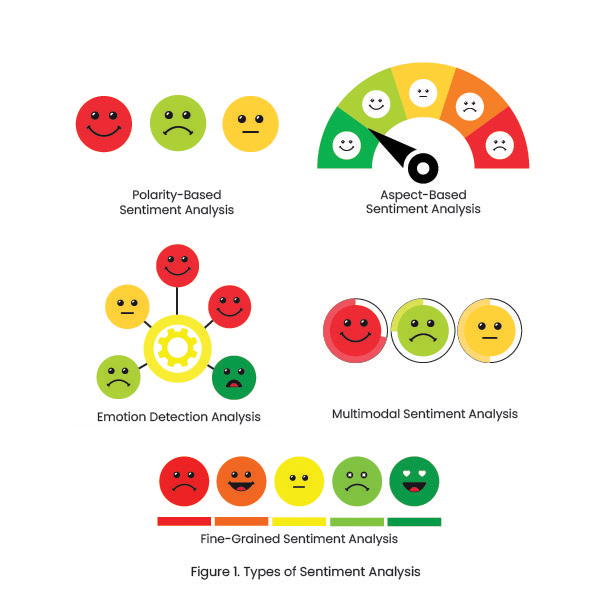
- Fine-Grained Sentiment Analysis (FGS-Analysis): This method provides sentiment on a more detailed and identified degree of positivity scale, such as very positive, slightly negative, etc. It thoroughly analyses customer satisfaction surveys or reviews so the manufacturer or business team can more intensely understand the customer's emotions.The following are examples and outcomes of this analysis:
- "This is the best product ever!" → Very Positive
- "It's not bad, but not good either." → Slightly Negative
- Intent-Specific Analysis (IS-Analysis): This method determines the intent behind the sentiment, such as purchase intent, complaint, or feedback. Thus, the manufacturer can understand the customer's natural feel and experience and plan for further enhancement or customisation of the product or subsequent service to retain the customer and attract more customers to their product or service. The following are examples and outcomes of this analysis:
- "Can I get a refund?" → Complaint
- "This looks great! How can I buy it?" → Purchase Intent
- Multimodal Sentiment Analysis (MS-Analysis): This method combines text, audio, and video inputs to analyse sentiment and extract the output, which is termed a multimodal sentiment analysis. It consumes more time but enhances the analysis exponentially more than other analyses. It mainly analyses videos, webinars, or customer service calls. The following are examples and outcomes of this analysis:
- A customer's tone in a support call indicates frustration despite neutral words.
- The interview process and evaluation through a recorded video
- Comparative Sentiment Analysis (CS-Analysis): This method compares sentiments across different entities or topics and evaluates competitor performance based on customer feedback. The following are examples and outcomes of this analysis:
- "Brand A's service is much better than Brand B's."
- Brand A → Positive
- Brand B → Negative
- "Brand A's service is much better than Brand B's."
- Social Sentiment Analysis (SS-Analysis): This method focuses on the sentiment in social media platforms to monitor trends and brand reputation and combines the analysis of Twitter, Facebook, or Instagram for real-time sentiment tracking. The following is a classic example and outcome of this analysis:
- "I love the new feature on this app!" → Positive Social Sentiment
Essential Techniques in Sentiment Analysis
Sentiment analysis involves various computational methods to extract data, classify it, and evaluate sentiments expressed in text. The choice of technique depends on the complexity of the task, the given dataset, and the level of analysis required, based on our demand. Below is a detailed exploration of the essential techniques used in sentiment analysis.
- Rule-Based Approaches: Rule-based sentiment analysis relies on predefined rules and dictionaries (lexicons) created using domain expertise, business inputs, and historical data. These lexicons contain lists of words labelled with sentiments, such as "amazing" (positive) or "terrible" (negative):
- How It Works:
- Each word or phrase is assigned a sentiment score based on a sentiment lexicon.
- Grammatical rules are applied to handle negations (e.g., “not happy”), modifiers (e.g., “very good”), and intensifiers.
- For instance, a phrase like "not great" is adjusted to reflect a negative sentiment.
- Advantages:
- Simple and interpretable.
- Effective for basic tasks or small datasets.
- Disadvantages:
- Limited context understanding (e.g., sarcasm).
- Requires significant manual effort to create or update rules.
- How It Works:
- Machine Learning-Based Approaches: Machine learning techniques classify sentiment using algorithms such as Naive Bayes, Support Vector Machines (SVM), Logistic Regression, and Decision Trees. These methods require a well-prepared dataset, collected from relevant sources, cleaned, and labelled, to train and test the models for accurate sentiment prediction effectively.
- How It Works:
- Data Preparation:
- Clean and preprocess the text (e.g., remove noise, tokenise).
- Convert text into numerical features using techniques like Bag-of-Words, TF-IDF, or word embeddings.
- Model Training:
- Use labelled data to train machine learning models with tools like Scikit-learn, Pandas, NumPy, and NLTK.
- Sentiment Classification:
- Apply the trained model to new or unseen data to predict whether the sentiment is positive, negative, or neutral.
- Data Preparation:
- Advantages:
- Scalable and adaptable to new datasets.
- Handles large volumes of data efficiently.
- Disadvantages:
- Requires labelled training data.
- Limited contextual understanding compared to deep learning.
- How It Works:
- Deep Learning Approaches: Advanced neural networks, such as Recurrent Neural Networks (RNNs), Long-Short-Term Memory (LSTM) networks, and Transformers, are widely used for sentiment analysis. These models are typically built using frameworks like TensorFlow, PyTorch, and Hugging Face Transformers, leveraging powerful pre-trained models such as BERT, GPT, and RoBERTa.
- How It Works:
- Embedding Layer: Text is transformed into dense vector representations using word embeddings like Word2Vec, GloVe, or BERT embeddings.
- Neural Network Models
- RNNs: Handle sequential text data by retaining context from previous words.
- LSTMs: Extend RNNs to capture long-term dependencies better and improve performance on longer sentences.
- Transformers (e.g., BERT, GPT): Use self-attention mechanisms to model complex word relationships and context across the text.
- These deep learning models enable a more nuanced understanding of language, making them well-suited for complex sentiment analysis tasks.
- Advantages:
- Handles complex and contextual text data effectively.
- Pre-trained models significantly reduce training time.
- Disadvantages:
- Computationally intensive compared to other methods
- Large datasets are required for training if pre-trained models are not used.
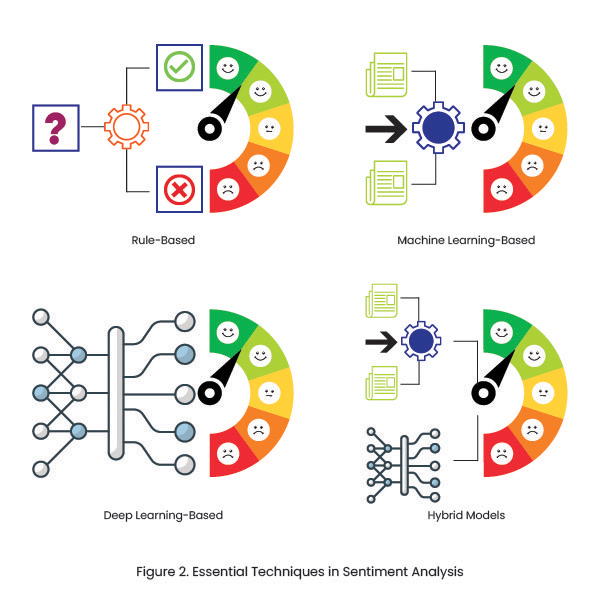
- Hybrid Models: Hybrid models in sentiment analysis combine the strengths of rule-based methods with machine learning or deep learning techniques to enhance accuracy and reliability.
- Rule-based systems handle straightforward tasks like detecting negations, modifiers, and intensifiers (e.g., "not good" or "very happy").
- ML/DL models then analyse deeper patterns and classify sentiment based on the broader context of the data.
This combined approach balances interpretability (from rules) and scalability (from learning models), making it ideal for analysing complex and domain-specific datasets. Hybrid models are also more flexible and perform well across various real-world applications.
- How It Works:
- Preprocessing: Use rule-based logic to clean and prepare the text, handling key modifiers and negations.
- Classification: Apply machine learning or deep learning models to perform the final sentiment analysis based on learned patterns.
- Advantages:
- Balances simplicity and accuracy since the data has been prepared based on the rule-based system.
- Leverages the strengths of both approaches, such as machine learning and deep learning
- Disadvantages:
- Increased complexity in implementation since we are applying rule-based and ML or DL models
- Requires careful integration of components since multiple models are involved
Steps to Become Proficient in Sentiment Analysis
Sentiment analysis is a journey that requires a strong foundation in understanding data, its purpose, and the type of sentiment analysis to be carried out for the given problem statement. Additionally, we should have an extensive understanding of NLP, familiarity with Machine Learning and Deep Learning techniques, and hands-on practice with real-world data. With this, we can decode various emotions from text, images, audio and video inputs.
The following steps will help you develop proficiency in building effective sentiment analysis systems alongside unlocking valuable insights from various inputs and patterns for multiple industries and high-demand applications.
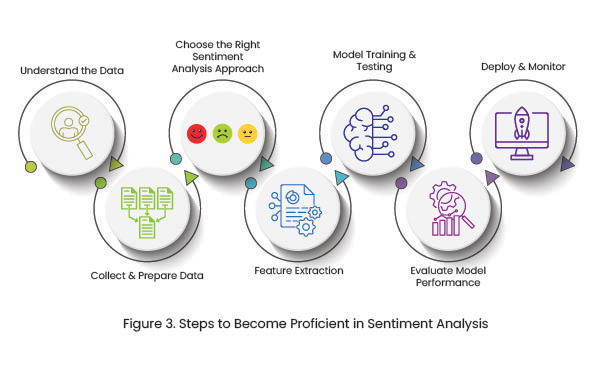
Understanding the Data: Understanding the data is critical in every data-driven project; then, we can correlate it with the problem or innovative idea implementations. Collect textual, audio and video data from diverse sources like social media, reviews, and survey aspects precisely. Start by learning the fundamentals of Natural Language Processing (NLP), DL, and Gen AI to explore the possibilities of multimodal analytics and grasp the core concepts of sentiment analysis in multi-dimensions, which is key to success in delivering AI-powered applications or as a product.
Collect and Prepare Data: Once we understand the nature of the innovative idea or given a problem statement for building a sentimental analytics tool, we have to gather the valued data from relevant sources, such as social media, reviews, or surveys, and preprocess it by cleaning and removing the noise from the data, such as punctuation, handle misspellings or abbreviations, special characters, and stop-words followed by tokenising, stemming lemmatisation, and stop-word removal to clean and structure data for analysis and collecting appropriate audio and video data with high-quality parameters.
Choose the Right Sentiment Analysis Approach: Once the data collection and preparation process is completed, depending on your project's complexity and data volume, you must decide between rule-based, machine-learning, or deep learning methods. Each approach has its characteristics and impacts.
Rule-Based Methods: This approach collects the defined rules and sentiment lexicons and is simple and effective for straightforward text analytics.
Machine Learning Models: Typically, this approach looks ahead to the structured data for analysis, and we can employ a set of algorithms like Naive Bayes, SVM, or Logistic Regression for a more scalable and flexible sentiment analysis and a responsible model.
Deep Learning Techniques: This approach typically uses unstructured data like audio and video and leverages advanced models such as LSTMs, BERT, or GPT for complex and context-aware sentiment detection; this approach is more computationally expensive than others.
Feature Extraction: Feature engineering is an essential process for machine learning solutions, and feature extraction plays a vital role in selecting the right features for analysis. Specifically for text and classification analytics, we must incorporate this stage to enhance the model's performance extensively. Some of the specific methods are as follows:
- Use bag-of-words or TF-IDF (Term Frequency-Inverse Document Frequency) for traditional feature extraction.
- We use word embeddings (Word2Vec, GloVe, FastText) or contextual embeddings (BERT, RoBERTa) to capture semantic relationships.
Model Training and Testing: After data preparation, cleaning, and feature engineering, the primary activity in this analysis is selecting the model, training the data, and monitoring the performance. The central aspect is that the data must be labelled as datasets to train the model and evaluate its accuracy. Labelled datasets can also train models, experimenting with algorithms like Naive Bayes, SVM, or neural networks for better results. This must be experimented with relevant algorithms and different hyperparameter tuning to identify the best-performing model.
Evaluate Model Performance: As usual, once the model is selected, trained, and tested, it must be evaluated by assessing its accuracy, precision, and recall, ensuring reliable sentiment classification, refining the model as needed, and confirming that it is the right choice for our sentiment analysis. The following metrics are significant and specific to the algorithm used for the analysis: Precision, Recall, F1 score, and ROC-AUC metrics. Cross-validation to ensure model reliability by testing it on unseen data.
Deploy and Monitor: After model evaluation, we are all set to deploy the model into production, monitor its performance regularly, and continuously refine the sentiment analysis solution in a real-world environment. Of course, the sentiment analysis model can be implemented in a real-world application and constantly monitored, like Azure Monitor, to track performance, identify areas for optimisation, and update to handle evolving trends and data patterns. Additionally, the following activities and monitoring are necessary.
Integration: Deploy the sentiment analysis model into a real-world application, such as a chatbot, dashboard, or analytics platform.
Feedback Loop: Continuously update the model with new data to maintain relevance and accuracy.
Applications of Sentiment Analysis
Sentiment analysis tools and applications are mainly used in real time, offering powerful insights that help businesses, governments, and organisations respond quickly and plan strategically to enhance services to the public or employees based on the use cases. Let's discuss them from various organisations' perspectives.
Social Media Monitoring
Social media monitoring based on sentiment analysis is mainly carried out to help various organisations understand their product values and market demand. E-commerce and product reviews analyse real-time customer reviews and ratings to improve products and services.
- Purpose: Track brand reputation and customer sentiment on platforms like Twitter, Instagram, and Facebook.
- Example: Identifying public sentiment during a product launch or PR crisis.
Customer Support and Chatbots: In recent trends, customer interactions with support executives increasingly occur through chatbots, resulting in numerous conversations ranging from happy to heated discussions. However, determining whether the customer was satisfied with the support provided or assessing the behaviour of both parties can be challenging. Sentiment analysis offers a solution by evaluating these conversations to enhance services, foster a positive relationship between the customer and the support team, and capture valuable feedback. This feedback loop helps organisations refine their services, ensuring continuous improvement and customer satisfaction.
- Purpose: Enhance customer interactions by analysing emotions in live chats and call transcripts.
- Example: AI chatbots adapting responses based on the customer's emotional tone.
Financial Market Analysis: Market analysis is a significant task for sentiment analysis, especially in the financial sector, to expand its services. It ultimately gauges investor sentiment to predict stock market trends and support financial institutions in effectively performing well and forecasting their plans. Financial market analysis empowers stakeholders with advanced tools to navigate complex market dynamics effectively. By leveraging its predictive capabilities and real-time insights, the financial sector can enhance decision-making, improve efficiency, and achieve better outcomes in a highly competitive environment.
- Purpose: Gauge investor sentiment to predict stock market trends and align with expectations.
- Example: Monitoring Twitter sentiment around a specific stock or cryptocurrency to guide investment strategies.
Political Sentiment Tracking: Political sentiment tracking uses sentiment analysis to gauge public opinion on political campaigns, policies, and events by analysing social media posts, news articles, and public forums. With the help of real-time analysis of voter sentiment during debates, rallies, or legislative announcements, the private organisation enables and executes this political sentiment tracking and creates awareness among the public to understand which political party is performing better and reliably to vote for them and political organisations understand voter sentiment, identify critical issues, and adapt strategies in real-time. During elections, this tool can track shifts in public opinion and predict voter behaviour.
- Purpose: To measure public opinion on political campaigns, policies, or events and to understand voter sentiment.
- Example: Tracking sentiment shifts on Twitter during an election speech.
Healthcare and Patient Feedback: Sentiment analysis in healthcare and patient feedback helps healthcare organisations understand patient emotions, concerns, and level of satisfaction with the service provided by healthcare by analysing reviews, surveys, and communication records precisely. It identifies recurring issues, problems, and missing factors regarding dissatisfaction with wait times or praise for medical staff and doctors and enables targeted service improvements. This analysis can also detect potential mental health concerns or patient discomfort through language patterns. By leveraging AI-driven sentiment insights, healthcare providers can enhance patient experiences, streamline operations, and foster trust. Real-time sentiment tracking ensures prompt responses to patient needs, improving overall care quality.
- Purpose: Analyse patient feedback to improve healthcare services and patient satisfaction.
- Example: A hospital identifies areas of improvement from real-time negative feedback on social platforms.
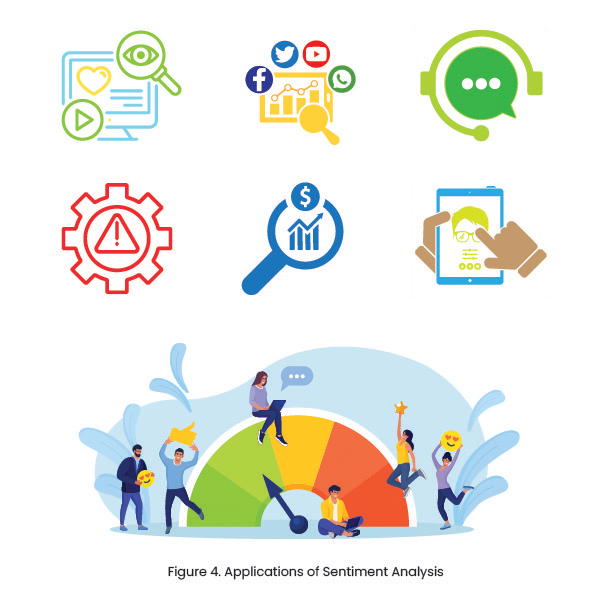
Crisis Management: Sentiment analysis in crisis management helps organisations monitor public emotions, reactions and opinions during critical events such as natural disasters, product recalls, etc. Analysing real-time data from social media, news, and customer feedback identifies rising issues and sentiment trends from that data. Its ability to provide actionable insights makes it a vital tool for managing crises with precision and empathy.
- Purpose: Detect emerging issues or public dissatisfaction to enable timely responses.
- Example: A company addresses negative sentiment about a data breach before it escalates.
Employee Engagement and Feedback: Employee engagement and feedback are critical parameters for the organisation to retain employee-employer relationships, reduce attrition, build goodwill, and create a healthy environment. Employee sentiment can be monitored through internal communication channels or surveys to enable this. It identifies trends, such as dissatisfaction with management or positive reception of workplace initiatives, enabling proactive measures to improve employee well-being. Ultimately, real-time feedback from virtual and skip-level meetings should be analysed to improve team morale and management engagement with employees. This reduces turnover and aligns workplace strategies with employee needs, creating a more motivated and cohesive workforce. This exercise helps organisations gauge employee morale, satisfaction, and concerns.
- Purpose: Monitor employee sentiment through internal communication channels or surveys.
- Example: Analysing real-time feedback from virtual meetings to improve team morale.
Challenges in Sentiment Analysis
Sentiment analysis faces several challenges that affect its accuracy and effectiveness. Ambiguity in language can also create confusion, as the exact words may have different sentiments in different contexts, so it isn't easy to analyse. A domain-specific language adds complexity in some situations, requiring machine learning or deep learning models to be fine-tuned for industries like healthcare or finance. Multilingual analysis is more challenging than other analyses due to linguistic and cultural nuances and meaning. Data quality issues, such as noisy or biased datasets, can negatively impact model performance, and additional costs and effort are needed to address these issues. Additionally, detecting mixed emotions in a single text and maintaining context in long texts remain significant hurdles and might turn on unnecessary alarms. Finally, ethical concerns, such as privacy and bias in AI models, are critical and must be addressed for responsible implementation.
Ambiguity and Sarcasm: Discarding sarcasm and ambiguous statements for sentiment analysis and outcomes is a considerable challenge.
Context Awareness: The ML or DL models must understand cultural and contextual nuances for accurate sentiment detection, which is a significant challenge since they can perform the classification analysis.
Data Quality: Data quality plays a significant role in any ML, DL, or Gen AI solution, so inconsistent or biased datasets can significantly affect model performance.
Scalability: Handling large volumes of real-time data requires robust computational resources, so sentiment analysis should be scalable.
Tools and Technologies
So far, we have discussed various sentiment analyses and steps to implement them; of course, this is a highly recommended tool and technology.
Python Libraries: Pandas, NumPy, Scikit-learn, NLTK, SpaCy, and TextBlob for fundamental sentiment analysis. Hugging Face Transformers for advanced deep learning models.
APIs: Azure Cognitive Services, Google Natural Language API, and IBM Watson for plug-and-play sentiment analysis.
Machine Learning Platforms: TensorFlow and PyTorch are used to build custom models.
Conclusion
Mastering sentiment analysis is a journey that requires a strong foundation in NLP, familiarity with machine learning and deep learning techniques, and hands-on practice with real-world data to derive solutions. We discussed various approaches and steps to implementation. The choice of sentiment analysis technique depends on the use case, dataset, and available resources.
While rule-based and lexicon-based methods are simple and effective for basic tasks, Machine Learning and Deep Learning approaches offer greater accuracy and adaptability for complex scenarios involving structured and unstructured data and sentiment analysis. A hybrid approach helps the models and contextual techniques ensure the best of both worlds, making sentiment analysis a versatile and essential tool for businesses, researchers, and developers.
Mastering sentiment analysis equips individuals and organisations with the ability to decode emotions embedded in the text, unlocking valuable insights that drive better decision-making. By leveraging AI's predictive capabilities and real-time insights, organisations can enhance decision-making, improve efficiency, and achieve better outcomes in a highly competitive environment.




